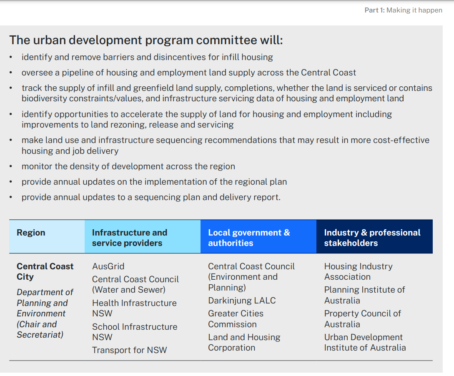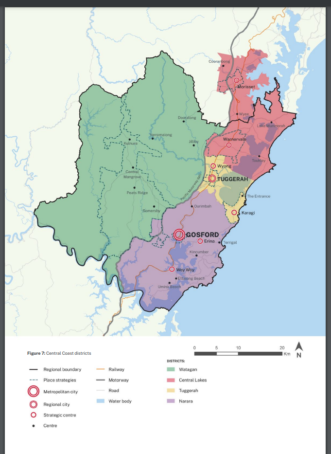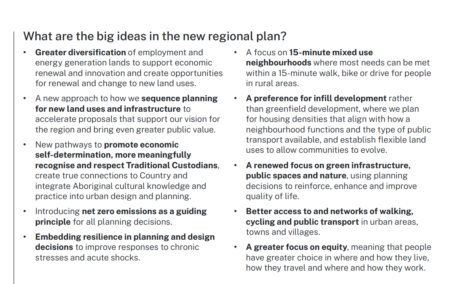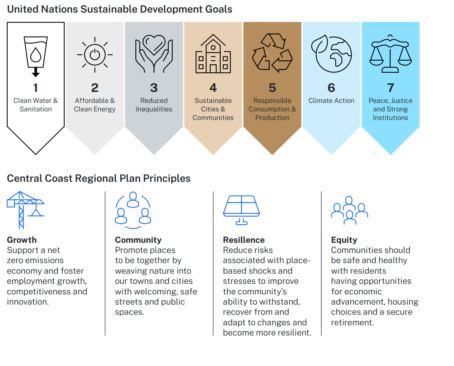The State Government launched the Central Coast Regional Plan (CCRP) on October 27.
It is the latest in a long line of “plans” for the Coast and it’s not the end of the line: more plans are coming.
The Coast is part of the Six Cities Vision and this CCRP outlines our part in that jigsaw puzzle.
The Greater Cities Commission is writing up a “Central Coast Strategy for Economic Growth” plan which will complement this regional plan (CCRP).
The Strategy for Economic Growth’s job will be to “accelerate the CCRP’s commitments with clear actions and funding”.
The CCRP will have the status of a district strategic plan – but only until the Greater Cities Commission produces its own Six Cities Regional Plan and its Central Coast City Plan commences.
So plans at six paces, whichever way you look.
But what is the main focus of the CCRP?
More houses, basically, is how this journalist reads the document.
The plan talks about nine objectives but more housing seems most important when it comes to the detail.
The regional plan will shape how the State Government will collaborate with Council, Darkinjung Local Aboriginal Land Council, state agencies and those “stakeholders” on the regionally significant growth areas so that the housing is delivered quickly.
And to make sure that happens, you need a committee!

The State Minister for Planning Anthony Roberts says a core part of the delivery will be an Urban Development Program Committee, to help manage land and housing supply, and assist with infrastructure coordination.
“This will help ensure there is 5 years of zoned and developable land, enabling more homes for families and those seeking to be part of the great communities all along the Central Coast,” he says in the foreward to the plan.
But on top of that, a plan to develop a particular area might need a Place Delivery Group (PDG).

“The place-delivery group will be established to resolve planning and infrastructure constraints for an area undergoing significant change,” the plan explains.
As well as more houses, the plan identifies that more “employment lands” are needed so that means more partnerships are needed.
“The supply of zoned and serviced employment land requires a partnership between the NSW Government and Council, infrastructure providers and the development industry,” the plan explains.
The department will produce an annual report on the delivery and implementation of the regional plan.
But for us poor locals, it’s a confusing document.
We now have four new districts.
Narara is no longer just Narara.

1/ Narara District (purple) takes in a huge area.
“The Narara district is the Central Coast’s major urban area, incorporating the regional capital of Gosford, strategic centres of Woy Woy and Erina, the emerging centre of Lisarow and tourism centres at Ettalong Beach, Umina Beach, Terrigal and Avoca Beach,” the plan states.
“Each of these places has its own culture and history to be celebrated in future planning.”
2/ A Central Lakes District (what colour is that: Mango??) takes in not only Warnervale and Munmorah but also Morisset which is not in the LGA of the Central Coast but is part of Lake Macquarie Council area.
3/ The tuggerah District (yellow) takes in the Tuggerah to Wyong Growth Corridor and the health precinct surrounding the redevelopment of Wyong Hospital but also establishes a new strategic centre and regionally significant growth area known as Karagi (Aboriginal name for the channel) that integrates future development around The Entrance, Long Jetty, Bateau Bay and Killarney Vale.
4/ The Watagan District (Green) includes Jilliby, Yarramalong, Kulnura, Dooralong, Central Mangrove, Mangrove Mountain, Peats Ridge and Calga. To me, this is confusing as the Watagan Mountains is a particular area north of those areas.
Within all the four districts, there are pages and pages of planning priorities and “place strategy outcomes” relating to the different areas. I urge local community groups to become acquainted with those priorities and outcomes if you want to keep abreast of current thinking for your area.
Why? Because this is the blueprint. And we have no councillors.
We have one administrator instead of 15 councillors. He needs to know you’re interested in all this.
The CCRP has nine objectives with a lot of details for each objective which I haven’t included here.
Objective one
A prosperous Central Coast with more jobs close to home
Objective two
Support the right of aboriginal residents to economic self-determination
Objective three
Create 15 minute neighbourhoods to support mixed, multi modal, inclusive and vibrant communities
Objective four
An interconnected Central Coast without car dependent communities
Objective five
Plan for nimble neighbourhoods, diverse housing and sequenced development
Objective six
Conserve heritage, landscapes, environmentally sensitive areas, waterways and drinking water catchments
Objective seven
Reach net zero and increase resilience and sustainable infrastructure
Objective eight
Plan for businesses and services at the heart of healthy, prosperous and innovative communities
Objective nine
Sustain and balance productive rule landscapes
Each objective has a number of performance outcomes and strategies to get there.
Again, in my opinion, it is worth local communities reading this document to understand the focus for these objectives and what that means for their areas.
The CCRP 2041 replaces and repeals the:
- Central Coast Regional Strategy 2006-31
- North Wyong Shire Structure Plan, 2012
- Central Coast Regional Plan 2036
And last but not least, the document has this disclaimer:
“The information contained in this publication is based on knowledge and understanding at the time of writing (October 2022) and may not be accurate, current or complete. The state of New South Wales (including the NSW Department of Planning and Environment), the author and the publisher take no responsibility, and will accept no liability, for the accuracy, currency, reliability or correctness of any information included in the document (including material provided by third parties). Readers should make their own inquiries and rely on their own advice when making decisions related to material contained in this publication.”
See the document here: https://www.planning.nsw.gov.au/centralcoast2041





re: infill development. This motion is understood as a ‘need’ in accommodating a growing population BUT it seems that off-street parking is not included in the application process. The spate of ‘granny flats’ being built seem to be a quick answer for our community. Many infill developments appear to impede traffic thoroughfare due to, either, not enough parking space onsite or none whatsoever thus the ‘extra’ street parking, especially in the newer suburbs which have laneways and narrow streets. All of this is detrimental to the streetscape and community access.
I would feel more comfortable with these momentous plans if we had local councillors capable of looking after the areas they represent and live in. However, I probably won’t live long enough to see see most of this come to fruition.